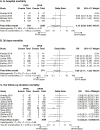Clinical outcomes of transcatheter versus surgical pulmonary valve replacement: a meta-analysis
- PMID: 32030252
- PMCID: PMC6988062
- DOI: 10.21037/jtd.2019.11.64
Clinical outcomes of transcatheter versus surgical pulmonary valve replacement: a meta-analysis
Abstract
Background: Transcatheter pulmonary valve replacement (TPVR) has currently been a well-established alternative operation method to surgical pulmonary valve replacement (SPVR) in patients with pulmonary valve dysfunction in the form of stenosis and/or regurgitation. We conducted a meta-analysis to evaluate the main clinical outcomes after TPVR and SPVR.
Methods: We systematically searched the references of relevant literatures from PubMed and the Cochrane Library published between January 2000 and December 2018 and followed The Preferred Reporting Items for Systematic reviews and Meta-analysis (PRISMA) for this study.
Results: Eleven studies with 4,364 patients were included in the study. Compared with SPVR, TPVR results in a significant decreased in-hospital mortality [odds ratio (OR): 0.18; 95% confidence interval (CI): 0.03-0.98] and mortality at the longest reported follow-up time point (OR: 0.43; 95% CI: 0.22-0.87), though 30-day mortality (OR: 0.38; 95% CI: 0.11-1.33) has no significant difference between groups. Days of hospital stay [(mean difference (MD): -4.38; 95% CI: -6.24--2.53] is shorter with TPVR than SPVR. Besides, rates of 30-day readmission (OR: 0.67; 95% CI: 0.50-0.91) and recurrent pulmonary regurgitation (OR: 0.17; 95% CI: 0.07-0.42) are lower with TPVR, whereas postprocedural infective endocarditis (IE) (OR: 4.56; 95% CI: 2.03-10.26) are higher with TPVR. SPVR carries a decreased risk of re-operation (OR: 2.19; 95% CI: 0.62-7.76) though without statistically significance.
Conclusions: In conclusion, TPVR is associated with a significantly decreased mortality, a shorter length of hospital-stay, a lower rate of 30-day readmission and recurrent pulmonary regurgitation as compared to SPVR throughout the follow-up duration, whereas SPVR results in a significantly lower rate of postprocedural IE than TPVR. In addition, SPVR carries a decreased risk of re-operation with statistically insignificance.
Keywords: Surgical pulmonary valve replacement (SPVR); meta-analysis; transcatheter pulmonary valve replacement (TPVR).
2019 Journal of Thoracic Disease. All rights reserved.
Conflict of interest statement
Conflicts of Interest: The authors have no conflicts of interest to declare.
Figures




Comment in
-
Transcatheter pulmonary valve replacement: an option for some but not for all.J Thorac Dis. 2020 Nov;12(11):6422-6425. doi: 10.21037/jtd-20-1621. J Thorac Dis. 2020. PMID: 33282344 Free PMC article. No abstract available.
References
-
- Warnes CA, Williams RG, Bashore TM, et al. ACC/AHA 2008 Guidelines for the Management of Adults with Congenital Heart Disease: Executive Summary: a report of the American College of Cardiology/American Heart Association Task Force on Practice Guidelines (writing committee to develop guidelines for the management of adults with congenital heart disease). Circulation 2008;118:2395-451. 10.1161/CIRCULATIONAHA.108.190811 - DOI - PubMed
LinkOut - more resources
Full Text Sources
